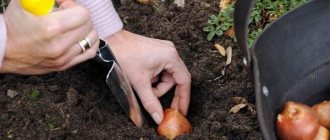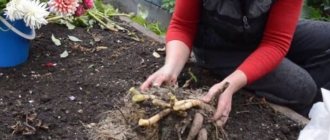It is simply impossible not to love dahlias. Everyone who has their own plot of land always tries to make room for at least a couple of bushes of these amazing flowers. Today there are a lot of varieties and varieties, so everyone can find a plant variety for themselves. Only when the flowering time ends and the first frosts strike does the question of how to store dahlias in winter at home become acute, so as to enjoy their lush flowering next year. In this article, experts from the Agronom.guru portal will talk about how to properly store planting material, what conditions are necessary for this, and what to do if the tubers did not survive the winter well.
Dahlias amaze with their beauty and grace. They delight the eye with a riot of colors from the beginning of summer until the frosts
Preparing dahlias for winter - what needs to be done with them before storage
After the first frost hits, they begin preparing the dahlias for wintering. First of all, they carefully inspect the bushes and discard plants with obvious signs of disease. You should not feel sorry for them and try to give them a chance, because during storage healthy tubers may become infected and all the flowers will die. After culling, they begin to clean the soil around the bushes.
Plants that show obvious signs of any disease are immediately burned to prevent the outbreak from spreading. Weak dahlias are removed and sent to rot in a compost pit. It is noteworthy that the tubers accumulate a certain supply of moisture so that they can withstand drought. During storage, excess moisture can provoke rotting processes, so you should stop watering the flowers a week before the intended harvest.
Frozen dahlia tops should be trimmed
If frosts came unexpectedly and the dahlias did not have time to prepare for the winter period, then there is no need to rush to remove them. The tubers are left in the ground for as long as time allows. Frozen tops are cut off, leaving 15 cm above the soil surface. In this state, you can keep the bushes on the site for up to 20 days, which will give them the opportunity to ripen.
Dahlias cannot overwinter in open ground; in the fall they must be dug up and stored indoors. To do this, carefully dig up the soil around the bush with a shovel, remove the tubers and shake them off any remaining soil. You must work extremely carefully, trying not to injure the fragile roots. Finally, they are laid out in the open air and allowed to dry thoroughly.
After digging, the tubers must be thoroughly dried.
After the excavated material has dried, it is inspected to identify damage or the presence of diseases. They also get rid of old tubers that will no longer be able to produce buds next season. In addition, old rhizomes are very poorly preserved until spring, so it is not advisable to send them for the winter. They are easy to distinguish by their dark color, pronounced tuberosity and very large size compared to young ones.
There are two conflicting opinions about whether it is worth washing tubers before sending them for the winter. Some gardeners are supporters of the theory that washing significantly reduces shelf life and destroys the cambium. Others tend to believe that clean roots show damage and disease better.
Cleaning rules
A sunny, warm, dry day is ideal for harvesting dahlias. And starting work in the morning will help the tubers dry out during the day. Most gardeners are of the opinion that pruning stems and harvesting tubers must be done at the same time. This reduces the likelihood of infection by tuber neck viruses.
So, the basic cleaning rules:
- You should start with the stems. The upper part of the bush at a distance of 10-30 cm from the ground is cut off with disinfected pruning shears;
Cutting dahlia stems with pruning shears
- The soil around the bush is carefully dug to a depth of 25-30 cm so as not to damage the tubers;
- The forks are inserted deeper into the ground in order to pry up the root and completely remove the underground part of the bush.
When digging, it is optimal to use a pitchfork rather than a shovel.
Do not shake off the roots too much - this can damage the bulbs and stem.
The buds that form at the base of the trunk play the most important role in the next year's growing season. If during digging the trunk is damaged or pulled out, such bushes are thrown away; there will be no new plants from them.
It must be remembered that after cutting off the upper part of the stem, it becomes difficult to determine the variety of dahlias. Therefore, it is necessary to monitor the presence of tags indicating the variety. This will help in the future to beautifully design the landscape of your summer cottage, as well as to propagate the best varieties of dahlias.
How to store dahlias after digging - nuances of storage mode
It is very difficult to create ideal conditions for storing dahlias, but it is possible to get closer to them. It is especially useful for beginning gardeners to become familiar with the preferences of capricious beauties. Otherwise, there is a risk of destroying the tubers due to improper storage. So, you dug up the dahlias. Storing tubers in winter is best done under the following conditions:
- air temperature – at +5°С;
- optimal humidity - 60−75%;
- good ventilation of the room;
- air must circulate.
Proper storage is the key to success in the next season.
If you ensure the last two points listed, then the risk of fungal infections is minimized. It wouldn’t hurt to pre-disinfect the room or fumigate it with sulfur. The roots are laid in no more than 2 rows. The surface must be dry. The following are used as a substrate:
- dry sand (in rare cases - earth);
- sawdust or large wood shavings;
- any wooden surface.
New technique: wrapping tubers in cling film
Recently, it has been practiced to wrap tubers in cling film before sending them to storage, but this technique has a sufficient number of opponents who are inclined to argue that in such conditions fungal diseases multiply, plants breathe poorly, and the chances of surviving until They don't have much spring. Personally, I had a positive experience of storing dahlias in cling film (there was no other option), however, I will not say that this is one hundred percent effective.
Preparation for storage
Dahlia rhizomes need to be dug up in the second half of September or the first ten days of October, immediately after the above-ground part of the plant dies, which is first cut off, leaving 3-4 cm from the neck of the rhizome. The soil is removed from the dahlia tubers, being careful not to damage the roots and their surface.
Then the rhizomes are washed with water, soaked for 30 minutes in a strong solution of potassium permanganate and slightly dried. Those dahlia tubers that do not sink in water can be safely thrown away - they will not last until spring. The remaining tubers can be treated with a fungicide and dried. After 5 days, remove the dried dahlia roots. Places of cuts and damage must be treated with quicklime or ground activated carbon.
The next stage of preparation before sending dahlias for storage in the cellar is aging the tubers in a well-ventilated room at a temperature of +18...+20°C for a week. During this time, their surface will become rougher, cuts and damage will dry out, and the planting material will be stored better.
For ease of storage, rhizomes can be divided into separate nodules. After separation, the broken areas must be treated with lime.
Before sending for storage, different varieties, in order not to be confused, can be immediately wrapped in soft paper and signed. You should not use newspapers for this purpose - printing ink can damage the tubers. You can wrap dahlias of the same variety in plastic wrap to sign the whole package with a marker at once.
How to store dahlia tubers at home - why and how to label the roots
If there are at least several varieties of dahlias in the flower industry, then you will need to resort to labeling. This procedure is done to avoid re-sorting. In addition, the strongest tubers are marked with special signs, for example, asterisks. With the beginning of the new season, they can be used to obtain cuttings. Self-made tags are used for labeling. A piece of paper or a piece of plastic with the appropriate inscription is attached to the rope.
Labeling tubers will help avoid unwanted misgrading
You can also use the digital method for marking - apply it to the tubers or attach numbers in a certain order. In this case, you will also need an additional notebook for notes, where you will keep notes about which variety is indicated by which number. This procedure helps not to confuse the varieties of flowers and plant them in the garden bed in the required sequence.
Dahlia storage methods
It may seem strange to beginners, but there are several effective methods for preserving dahlia tubers in winter. You should choose the one that suits you best, taking into account the conditions, the availability of space and the ability to control the condition of the roots.
In sandboxes
One of the most common, affordable and reliable ways to preserve tubers. You will need to prepare a container with a volume of at least 20 liters in advance (the volume depends on the number and size of the roots). Dry sand is poured into it, and then dahlias are laid in 1 or 2 layers. A layer of burlap is placed on top. As evidenced by reviews from experienced flower growers, the roots are simply perfectly preserved in this way. In addition, if necessary, it is possible to control the condition of the tubers.
Storing tubers in boxes with sand is an old and proven method
The disadvantage of the method of preserving planting material in sand is that a lot of sand is needed. In the spring, the flowers may begin to germinate ahead of schedule, which will cause some inconvenience. The main threat to plants when stored in sand is excess moisture. Under no circumstances should the sand be moistened, even if it seems that it is very dry. Moisture in this case will promote rotting. Dry dahlias can still be revived, but rotten ones are no longer possible.
In boxes with sawdust
This technique is also worthy and effective for preserving tubers. However, for this you must choose large sawdust. It's even better to use shavings. Fine sawdust can draw out and absorb all available moisture. Often, both experienced and novice gardeners make a grave mistake when trying to preserve dahlias in sawdust - they place them in plastic bags. As a result, condensation accumulates, and the roots simply rot from excess moisture.
Storing dahlias in boxes with sawdust is a very effective method.
It is not recommended to store dahlia tubers near any vegetables or potatoes. The fact is that an unwanted excess of moisture appears there, leading to the emergence and spread of fungal diseases.
Use of vermiculite
A material such as vermiculite is able to perfectly retain the required amount of moisture. In such conditions there is no need to worry about the roots drying out. However, with the slightest increase in temperature, flowers may sprout prematurely and form suction roots, which is extremely undesirable. To avoid such troubles, it is better to purchase not garden vermiculite, but a special one - coarse-grained.
Storing tubers in vermiculite helps prevent them from drying out.
To implement this method, prepare a container of the required volume and pour a layer of vermiculite on its bottom. After this, a layer of tubers is laid. In this sequence, the entire volume is filled. Finally, a layer of cellophane or polyethylene is laid on top, and the container is sent to a cool place where it will be stored.
Waxing
This method is used only by the most skilled gardeners, since it requires a lot of labor and time. The efficiency of waxing dahlia tubers is very high. Moisture cannot evaporate through paraffin, thereby avoiding drying out. And the high temperatures that operate during the processing process help kill all existing pathogens.
Waxing tubers takes a lot of effort and time, but is very effective.
As soon as the paraffin hardens, the roots receive reliable protection from the effects of harmful environmental factors. However, this technique should only be used for early plant varieties, since it promotes later awakening of the buds and the formation of suction roots. The method is also relevant for those who are thinking about the question of how to preserve dahlias purchased in February. After all, at this time, as a rule, it is not possible to get dry sand or sawdust. Let's take a closer look at waxing technology.
The finished paraffin or candles should be finely chopped and placed in a metal pan, adding water. All this is placed on top of another container of water, thus creating a water bath. The paraffin is melted over very low heat until the thickness of the molten layer reaches a couple of centimeters. If the roots will not fit in the pan, they will need to be separated. Prepared and dried tubers are tied with thread and quickly dipped in paraffin, after which they are taken out and wait for the substance to harden. In the open air this happens very quickly.
Gladioli: harvesting and storing bulbs, practical tips for growing and storing. In a special publication on our portal, we will talk in detail about how to remove and store gladioli bulbs. You will learn the necessary parameters for storing gladioli in winter at home and the rules for planting and caring for gladioli in open ground.
Storage methods
Spacious containers, such as boxes, are most often used to store tubers. Since free space is necessary for free air circulation.
Dahlia tubers are stored in light substrates
The rule of breathability also applies to the covering substrate. For example, you can cover dahlias with garden soil; there is no need to cover the stems. A lighter and more “breathable” version of the substrate are: sand, ash, sawdust, and peat. They are used both together, by mixing, and separately. The main rule is that the substrate must be dry.
Each gardener chooses a method that is more accessible and convenient for himself. But it is worth remembering that you cannot store dahlias in plastic bags; the tubers in it will suffocate, rot and die.
If you follow the recommendations above, then the winter will be favorable for dahlia tubers. And disappointment in the form of rotten, unusable tubers will not befall you. Proper care will be rewarded. Lush, bright hats of flowers will be the best gratitude for you.
Where to store dahlias in winter - expert advice
It is important to choose not only the right method for storing dahlias in winter, but also to choose a good place for this. There are several options for where you can place the roots for safekeeping. Which one to give preference must be determined based on your capabilities.
The correct choice of storage location for dahlias guarantees their integrity
How to store dahlias in the basement in winter
If you have a basement, then it is recommended to arrange shelving there to store dahlia planting material. Subsequently, boxes or boxes can be installed on them. It is important to know what level of humidity and temperature remain in the room throughout the season. These factors significantly affect the safety of planting material.
It is convenient to store dahlias on racks in the basement
Tubers can be stored by placing them on shelves. However, if the basement is dry, then you will need to regularly humidify the air using a spray bottle, which is extremely inconvenient. Several times during the entire storage period it is necessary to sort through the root tubers and remove any that are damaged or have signs of disease. If the damage is minor, then you can cut off the sore spot, and then treat it with brilliant green, a good fungicide, or a strong solution of manganese. If the nodules begin to fade, then try to slightly increase the humidity level in the room by spraying with a spray bottle.
Storing dahlias in the cellar in winter
Dahlias love constant temperatures and do not tolerate freezing. If you have a cellar, then you need to know to what minimum the temperature in it can drop in the coldest months. If freezing is possible, insulation methods should be considered in advance.
A good cellar will help preserve dahlia tubers
The ideal cellar for good preservation of dahlia planting material is considered to be a cool and humid room in which the air temperature ranges from +1°C to +7°C and the humidity is maintained at 80-100%. In such conditions, the roots will not dry out or sprout prematurely. Not ideal, but an acceptable option would be a cool but dry cellar. But it’s better to avoid a warm and humid room altogether.
Storing dahlias in the apartment in winter
How to preserve dahlias in an apartment until spring? It is very problematic to preserve dahlias until spring. But nothing is impossible, and in the absence of other options, you can achieve the desired result. The main problem is a significant excess of the temperature in the apartment above those recommended for good preservation of root tubers. If you have a small number of roots, they can easily be placed in the plus compartment of the refrigerator. The fact that there is a lot of planting material will cause more inconvenience.
Preserving dahlias in apartment conditions is problematic, but possible
To store dahlias in an apartment, you can use well-insulated boxes that are placed on a closed balcony or loggia. In the event of a threat of a strong drop in temperature, when the thermometer drops below zero, the boxes are brought directly into the apartment and installed in the coolest place. As a rule, it is located near the balcony door. As soon as the threat of freezing has passed, the containers are returned to the balcony.
Determine the name of a garden flower from a photo. In a special publication on our portal we will talk in detail about garden flowers. You will learn about the types of garden flowers, perennials that winter in open ground and look at the photo gallery.
What to do with dahlias after winter storage, how to revive them
With warmer weather approaching, novice gardeners are thinking about what to do with dahlias after winter. It’s good if you got the tubers from the basement in perfect condition. But often the opposite is true, and it will take some effort to properly awaken the flower. The main spring problem, as practice and numerous reviews show, is the drying out of the roots. How to revive dahlias after winter, and is there any hope that they will bloom wildly?
A wilted tuber can still be revived
If the tubers have not completely dried out, but only withered, then they immediately begin rehabilitation. There is no need to rush to throw away the plant - it will always be done in time. You should take a container of suitable size and fill it with nutritious soil, peat or simple sawdust. Tubers are placed horizontally in this filler, trying not to bury them. The root collar must remain open. Plantings must be generously sprayed with zircon or Epin-Extra, diluted in accordance with the requirements in the attached instructions. Place the containers on a windowsill or in a well-lit place, placing plain paper on the glass. This will ensure good dispersion of the sun's rays. This procedure should be carried out in early March, depending on weather conditions.
Tubers after resuscitation begin to sprout after 3 weeks
For 3 weeks, carefully monitor the behavior of the tubers, preventing the filler from drying out and carrying out regular moistening. Under no circumstances should you allow excess moisture, much less stagnation of water. This will lead to the onset of rotting. After a month, you will find that the growth points begin to come to life (provided that the plant has not died). It is worth taking care of good lighting, because plants can stretch a lot. Moderate watering is required, but no fertilizing is necessary.
You can revive dahlias using a transparent plastic bag.
How to revive dahlias after winter if there is no filler? The method is, of course, risky, but if there is no other choice, it’s worth a try. You need to take a transparent plastic bag that has not been used before and place the spine in it. Next, prepare a growth stimulator solution or purchase a pre-prepared one and spray the tuber with it, then lightly tie the bag (to allow air access). Place everything in a well-lit, warm place and observe. If the moisture evaporates, additional spraying is carried out. As soon as the sprouts reach a height of 5 cm, they can be planted in the garden bed or in separate containers (depending on weather conditions).
Properly reanimated dahlias delight with exuberant flowering
When planting dahlia seedlings obtained in this way in open ground, they must be hilled. If there is a threat of night spring frosts, then the plants are covered with non-woven material. Agrospan, as well as Lutrasil, are suitable for this.
In this article we tried to talk in detail about how to revive dahlias after winter. What to do - the video will provide additional useful information and help you use our advice more effectively in practice.
X
When to dig
Frosts have a detrimental effect on the roots of dahlias, so they should be dug up in time and placed in optimal storage conditions. Professional gardeners advise leaving the tubers in the ground as long as possible. This is necessary for the roots to form correctly and mature. The first frost can be considered a signal that it is time to dig up the tubers.
Dahlias should be dug up after the first frost.
They occur differently in different regions. This period varies from early September to mid-October. Watch the dahlia bush. If the foliage is healthy, then the plant continues to prepare for winter by accumulating nutrients in the root system. If the first frost damaged it and the foliage began to dry out, then you have no more than three days to dig up the tubers. During this time nothing will happen to them.











